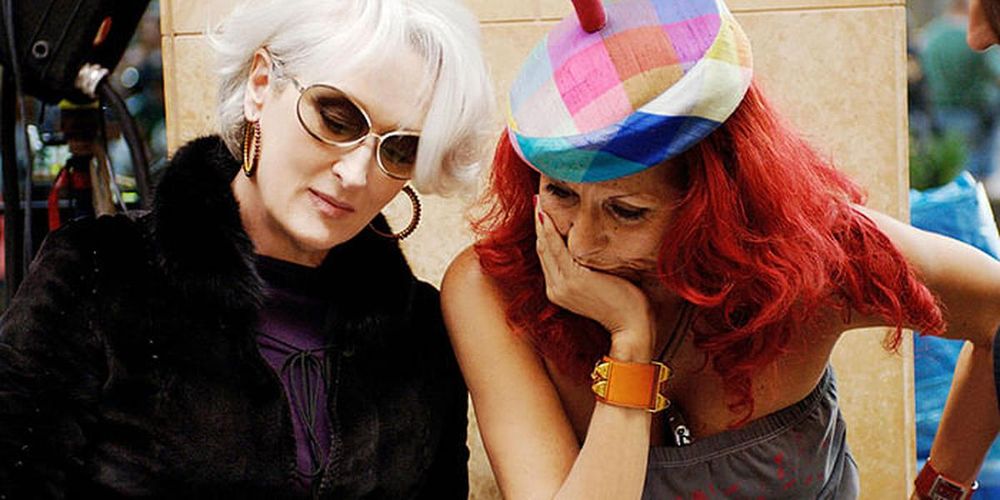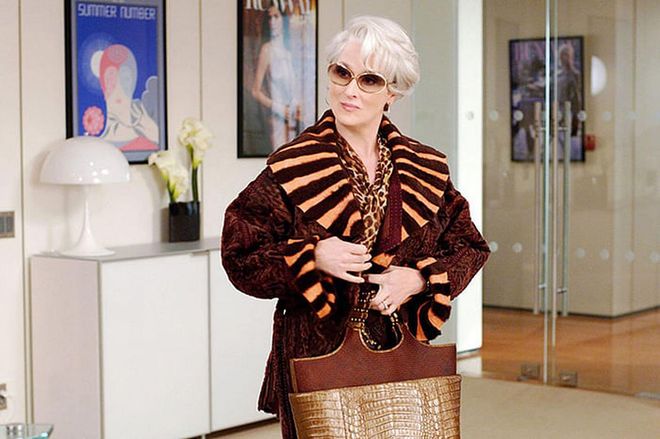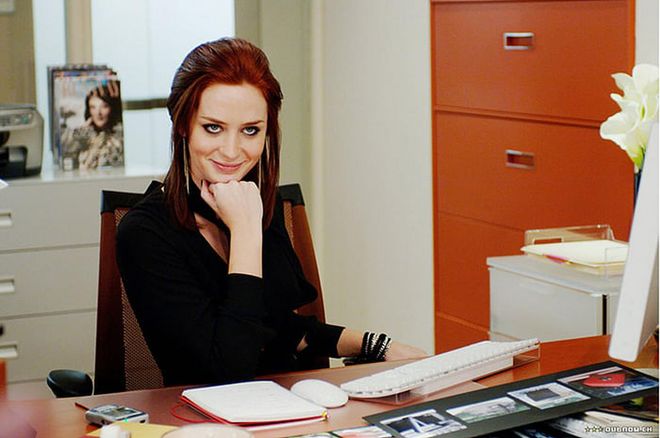Patricia Field On Creating The Look Of 'The Devil Wears Prada'
"Timelessness is a very important factor in whatever I do. That's what makes a classic."


Photo: Shutterstock / Rex
Patricia Field On Creating The Look Of 'The Devil Wears Prada'
Ten years ago today, The Devil Wears Prada premiered in theatres, and fashion has never been the same. From "Florals? For spring? Groundbreaking.", to "That's all.", the movie shined a glamorous—if not slightly brutal—light on the glossiest of industries. The woman behind the glamour? Super stylist Patricia Field (also of Sex and the City and Ugly Betty fame). Below, she opens up to HarpersBAZAAR.com about the legacy of the film and how she created the style of its iconic characters:
Harper's BAZAAR US: I can't believe it's been 10 years since The Devil Wears Prada came out. How do you think the fashion industry as a whole has changed since then?
PF: I think the fashion industry, as a result of globalisation, has undergone a uniformity. I'm not saying that's good or that's bad but that is my observation.
HB: How you were able to create individual personalities through the clothing of the main characters: Miranda, Andy and Emily?
PF: There's a formula you start off with and it starts with the script, because in the script it describes the characters and there's dialogue, and you learn about the character, who is fictitious, that we are creating. So that's step one: the script. Step two: character. Step three: Meet the actual human being, the actress or the actor. It's extremely important to have a relationship with the actor. I always feel my job is to support the actor who is creating this character.
The more information you have, the better you're able to have success. Part of that relationship is getting to know one another. You need to develop a respect, a trust for each other so that you're comfortable in this collaboration. So that's the general rule for all filmmaking for me. With Miranda Priestly, who is a chief editor, my idea was to create Miranda Priestly, not any other real chief editor, because it has to be an original for it to be interesting. Even though Devil Wears Prada originated as a book and it was in reference to Anna Wintour, I was not trying to recreate Anna Wintour. By no means. I was putting together a new formula that included very strongly the script and Meryl Streep. After meeting with her and talking with her, having a dialogue back and forth, you start to educate yourself . It's really important. Dressing is personal. I'd like to think that part of my formula, if possible, is finding any parallel lines between the character and the actor. If I can abstract those parallel lines and stay with them it becomes more organic and believable. Meryl had very good ideas that I liked very much, including her white hair, because I felt the white hair was a great palette. I could put anything to it. It was dynamic. That's an example of the kind of collaboration that I'm talking about. Some actors come with many ideas, some actors come with less ideas and say, "You're the expert, dress me, I don't know anything about fashion." Getting back to Meryl Streep, I wanted to create a fashion editor portrayed by Meryl, so it was very important that I understood her body, her ideas, and so on. After this so-called "research," I came up with—based on Meryl Streep—I went into the archives of Donna Karan, because when she started in the '80s and the '90s, her silhouettes were classic, they held up in time, they fit women, they flattered women, they weren't difficult. You can't start putting difficult clothes on a person. They're actors: they have to move, they have to feel real. And Donna said "Yeah, go to my archives." I went to New Jersey where she has a warehouse and I went through racks and racks, and I brought a lot of pieces out from there, and we used a lot of those piece. I was really happy because they weren't recognisable. The allowed Meryl to create her style, and I knew that fit-wise they would be good. They wasn't constricting or an outlandish shape or something like that.

Photo: 20th Century Fox
Patricia Field On Creating The Look Of 'The Devil Wears Prada'
HB: And Donna is famous for her workwear anyway.
PF: Absolutely. And the fact that I was in the archives, it was not recognisable. It wasn't Donna Karan 2016. It was very important for me be in that zone because I wanted, when people saw Meryl in these outfits, for it to look completely as her original style and not be distracted by the current trend.
HB: It's timeless.
PF: It is and I think timelessness is a very important factor in whatever I do. That's what makes a classic. It's obvious what's timeless and what is not timeless, but you need time to find that answer. I used it a lot for her workwear—she wore other designers, of course—but that was the foundation. It allowed me to create a style around it because it didn't dictate the style. It went with everything, you could wear it so many ways. So that is one of the main factors about Meryl as Miranda Priestly—that she have her own unique style. Style has become very important, the whole idea of style, what your personal style is. It's your identity, and that's what we're creating here.
When it came to Annie Hathaway, of course I went through the same exercise. I met her—I had never met her before—she was a young girl, just graduated out of being a princess for Disney—other than her role in Brokeback Mountain, which I thought she did a really good job in—so she was excited and open to this new stage in her life as an actress. She was optimistic, she was happy. I took on whatever information I received from her, and it was all positive. So the story is, she's a writer and all of a sudden she gets this job as this big deal fashion editor and she has no background in fashion at all. She starts out looking a bit grungy, non fashion-conscious. And along the storyline she develops into a little fashionista. After my meeting with her and understanding her personality, I got the idea that she's a Chanel girl. And when I spoke to Chanel—and here we go again: classic—when I spoke to Chanel they were very happy. They wanted to put their clothes on a young girl. They were very happy to work with me, which was great because there's nothing like cooperation when you're trying to paint a picture and you have all your paints there, and in this case the paint was Chanel. So her transition from the beginning to the end fit her persona. So there's that parallel line that I was talking about—it's believable about her, her whole persona. She's not Versace, for example. The expression comes in the styling and how you handle it. You take the classic and you take it on a little styling trip and then it becomes individual, original, interesting.

Photo: 20th Century Fox
Patricia Field On Creating The Look Of 'The Devil Wears Prada'
Emily Blunt, she's another one, I love her. She's very outspoken, her lines are underscored, she can handle extremes very well. Just based on my meeting her—I would bring her things and how she would react to it—she was my actress who I could be a little bit more expressive. I could take some chances, some liberties, because she could handle it within the way she delivered this character. She delivered it boldly and very expressively, so I linked that up with the wardrobe. And Stanley, I really didn't have a clue about this character. I went to my wardrobe fitting and I walked out understanding this character 100%. That was wonderful. He's fantastic, he can play anything. He and Meryl are the same in that sense. They can do any role and I so respect the two of them for that. They're not typecast in anyway. That is an actor, as opposed to a type that becomes a celebrity.
HB: Did Meryl offer any other input into what her character was wearing, aside from the white hair?
PF: Yes. Basically the process is, if she needs an outfit for a scene, I'm not gonna bring her one thing or she's gonna tell me this is what she wants. Based on the range of what she expresses and the range of what I bring her, I might bring her 10 different options she can choose. I think collaboration is extremely important in the process. And at the end of the day, I'm not on camera. Meryl is. The actor is. I think it's very important that they're involved. I never think of an actor as a model. A model wears what you tell them to wear, that's their job. An actor is different. It's important to work with the actor because in the end that's who the audience sees and that's the success that you need. Believable, great to look at, but it all has to come together. I notice a lot of people don't understand that aspect, they think it's more like fashion. I love to do fashion. I always put fashion in all of my storytelling because that's what I am, but I'm not selling clothes, I'm telling a story.
HB: Were those montage scenes particularly challenging? Gathering all those clothes and making sense as a whole?
PF: David Frankel, who is the director and writer and someone who I've worked with many times in the past—who I have a close relationship with—he would come into my office and say, "I just wrote a scene. It's a montage. Meryl is coming into the office and each time she comes into the office she throws another coat down and another coat down." And I go, "David, ca-ching ca-ching ca-ching!" Anyway, we did it. Those and the Annie montages in the street, those are some of the most remembered scenes. They were written after the main film script was written. They were add-ons as we were preparing. Also, I took David to Paris with me to couture. I said, "Come on, this is what you're gonna be shooting. You gotta come and see." We went and that really worked out very well. It inspired him.
HB: Did you design anything yourself for the film?
PF: I was asked to design a bag for Annie. It shifts into a clutch and has a circular handle that's part of the shape of the bag and it's got some fringe on it.
HB: Were there any designers that you were adamant about working with? Prada, Chanel…Valentino himself makes a cameo in the film.
PF: That was great, his cameo in the film. I love Valentino. I love his spirit, his love of life, his enjoyment of the whole experience. He's wonderful. I just landed on the designers as I got into the script and the actors. There were no imperatives. I used other designers besides the ones that I mentioned. But the main thing is, it's not about the designer as much as it's about the piece. Concerning Annie Hathaway, because she's in so much wardrobe, she had to have a style and I came up with the Chanel idea and that worked out. She didn't only wear Chanel. Same for Meryl regarding Donna Karan. Meryl wore some Prada, she wore different things. There wasn't just one thing. When Meryl went to work a lot of it was from the Donna Karan archive. It was important to me because in trying to create a style for this character, I didn't want the clothing to be current, on the runway or in the magazines, and be recognisable. I wanted it to be all Miranda Priestly, individual and original. It's like Anna Wintour has her own style, she's the original of it. Carine [Roitfeld], she has a completely different style, it's her style.

Photo: 20th Century Fox
HB: What was your favorite look to put together?
PF: Going back I liked them all, but based on the reaction, I know that when Anne does that Chanel transformation with the mini checked skirt and the thigh-high boots, people loved it. I put a twist on Chanel but the Chanel was there.
HB: How was designing for The Devil Wears Prada different from Sex in the City, a very fashion-heavy series?
PF: Well it was a different story. It was a different situation. You had different actors. You have to deal with each of them individually and the characters they're playing. It's hard to compare them because they're entirely different. It's really difficult to in any way to compare them. They're much easier to contrast than to find similarity. Again, it depends on the actor. You have somebody like Sarah Jessica Parker, who is a fashionista. She loves fashion. And that's a perk! And she can come with ideas because she's thinking about it. She loves fashion. So the collaboration yields a bonus that way. She loved her role as a supermodel. She loves that. That's like a gift. It's not fashion first, it's storytelling first. And then I throw my fashion and style into it because that's what I know and that's what I do. When you have actors who can support it, it's great. Sarah Jessica could be wearing a pair of five-inch heels and she's running down the street and her feet don't touch the ground. That's a beautiful thing to see. I can't make that happen. That has to come out of the actor. I can only recognise it and utilise it, but if it's not there I can't make it happen. You have to deal with a certain reality and expand it in anyway you can.
JK: Are you surprised by the staying power of the film and how beloved and iconic it is ten years later?
PF: I'm very happily surprised. I never thought that this would become a classic on its own. I never really thought about it going in, "I'm gonna make this the most unforgettable movie." I just go in and do my job and be positive and have fun with it. If I'm not enjoying it, it doesn't happen.
From: Harper's BAZAAR US